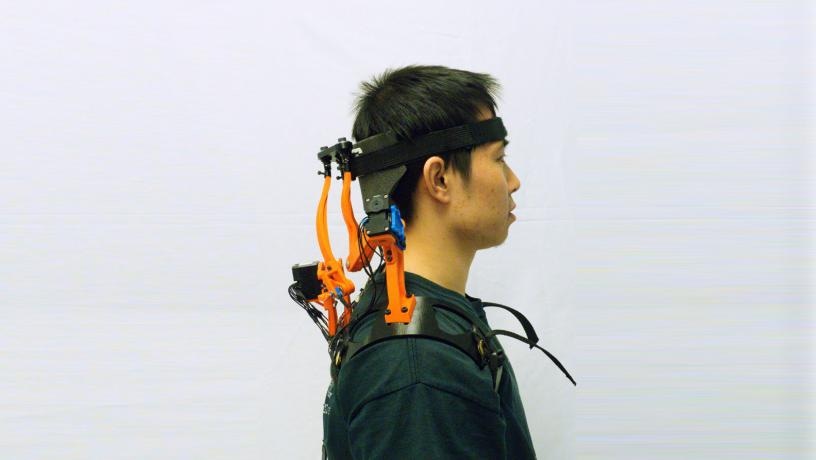Aug 13 2019
Columbia engineers have designed an innovative new neck brace that supports the neck during its natural movement.
 A study participant wearing the neck brace. (Image credit: Columbia Engineering)
A study participant wearing the neck brace. (Image credit: Columbia Engineering)
This is the first-ever device that has been shown to significantly help patients afflicted with amyotrophic lateral sclerosis, or ALS, in holding their heads and also actively supporting them during the range of movement.
This latest development would lead to a better quality of life for patients—for example, it would not only enhance eye contact during a conversation but would also enable the eyes to be used as a joystick to regulate movements on a computer, just like how scientist Stephen Hawkins famously did.
A group of neurologists and engineers, headed by Sunil Agrawal, professor of mechanical engineering and of rehabilitation and regenerative medicine, created a wearable and comfortable robotic neck brace that integrates actuators as well as sensors to modify the head posture, restoring about 70% of the active range of motion of the human head.
By utilizing concurrent measurement of the movement with sensors on the neck brace as well as surface electromyography, or EMG, of the neck muscles, it also turns out to be a novel diagnostic tool for impaired motion of the head-neck. The pilot study was reported in the Annals of Clinical and Translational Neurology on August 7th, 2019.
According to Agrawal, who directs the Robotics and Rehabilitation (ROAR) Laboratory, the neck brace also shows potential for clinical use apart from ALS.
The brace would also be useful to modulate rehabilitation for those who have suffered whiplash neck injuries from car accidents or have from poor neck control because of neurological diseases such as cerebral palsy.
Sunil Agrawal, Professor of Mechanical Engineering and Rehabilitation and Regenerative Medicine, Columbia University
“To the best of my knowledge, Professor Agrawal and his team have investigated, for the first time, the muscle mechanisms in the neck muscles of patients with ALS. Their neck brace is such an important step in helping patients with ALS, a devastating and rapidly progressive terminal disease,” stated Hiroshi Mitsumoto, Wesley J. Howe Professor of Neurology at the Eleanor and Lou Gehrig ALS Center at Columbia University Irving Medical Center.
Mitsumoto continued, “we have two medications that have been approved, but they only modestly slow down disease progression. Although we cannot cure the disease at this time, we can improve the patient’s quality of life by easing the difficult symptoms with the robotic neck brace.” Along with Jinsy Andrews, assistant professor of neurology, Mitsumoto co-headed the study with Agrawal.
ALS—often called Lou Gehrig’s disease—is a neurodegenerative disease that is defined by gradual loss of muscle functions, resulting in respiratory failure and paralysis of the limbs.
Dropped head, caused by decreasing neck muscle strength, is a defining trait of ALS. Over the duration of their illness, which can span from several months to over a decade, patients fully lose their head mobility, settling in to a chin-on-chest posture that affects swallowing, breathing¸ and speech. As the disease progresses, existing static neck braces become more and more ineffective and uncomfortable.
In order to test this novel robotic device, the researchers recruited 11 ALS patients together with 10 age-matched healthy subjects. The study participants were then asked to do single-plane motions of their head-neck that included axial rotation, lateral bending, and flexion-extension.
The experiments demonstrated that patients suffering from ALS, even in the extremely early stages of the disease, employ a different technique of head-neck coordination as opposed to age-matched healthy subjects. These traits are correlated well with clinical ALS scores that are regularly utilized by clinicians. The measurements, thus obtained by the novel device, can be utilized clinically to evaluate head drop and the progression of the ALS disease in a much better way.
“In the next phase of our research, we will characterize how active assistance from the neck brace will impact ALS subjects with severe head drop to perform activities of daily life,” stated Agrawal, who is also a member of Columbia University’s Data Science Institute. “For example, they can use their eyes as a joystick to move the head-neck to look at loved ones or objects around them.”
Demonstration of Robotic Neck Brace for ALS Patients
Demonstration of Robotic Neck Brace for ALS Patients (Video credit: Haohan Zhang and Sunil K. Agrawal/Columbia Engineering)